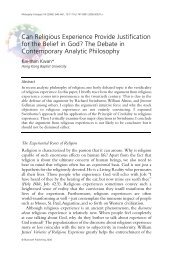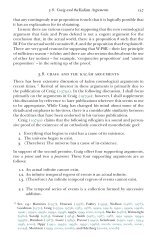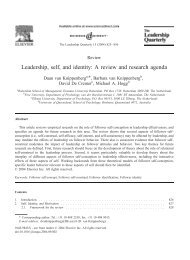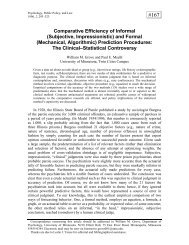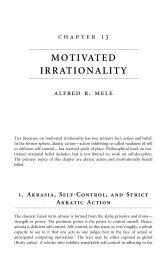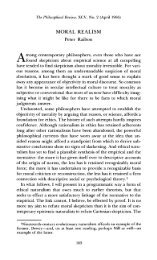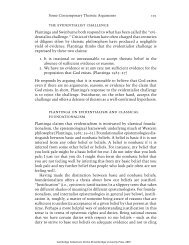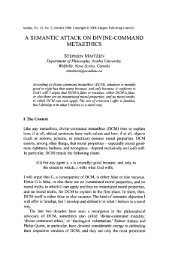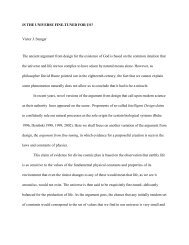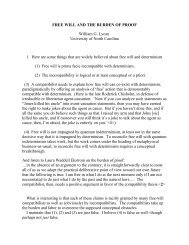Atheism and Theism JJ Haldane - Common Sense Atheism
Atheism and Theism JJ Haldane - Common Sense Atheism
Atheism and Theism JJ Haldane - Common Sense Atheism
Create successful ePaper yourself
Turn your PDF publications into a flip-book with our unique Google optimized e-Paper software.
<strong>Atheism</strong> <strong>and</strong> <strong>Theism</strong> 41<br />
If Field’s theory is accepted, we must say that there are no true existential<br />
mathematical sentences, <strong>and</strong> a fortiori no necessary ones. So Field’s theory<br />
does not help in the theist’s possible hope that mathematical necessity throws<br />
some light on what God’s necessary existence might be like.<br />
One philosopher who has strongly felt the mysteriousness of the set membership<br />
relation is David Lewis, who in his Parts of Classes 75 treats the relation<br />
of set to subset as the whole/part relation. (Classically, of course, this is done<br />
by defining subset in terms of set membership.) However, the notion of set<br />
membership still obtrudes in one place, the singleton relation, the relation of<br />
a thing to the set of which it is the only member. In an appendix with John<br />
P. Burgess <strong>and</strong> A.P. Hazen (explaining two methods due to these logicians)<br />
he gets over this problem but at a certain cost of empirical assumption as to<br />
what is in the universe, <strong>and</strong> also of structuralism, where one talks indifferently<br />
about many different subject matters. He also needs plural quantification,<br />
which is familiar in ordinary language as in ‘some critics admire only<br />
one another’. This sentence cannot be rendered into first order predicate logic<br />
without talking of sets of critics. George Boolos 76 gives the semantics in<br />
terms of second order logic, but Lewis cannot take this option because he is<br />
trying to replace set theory <strong>and</strong> he thinks of second order logic as ‘set theory<br />
in sheep’s clothing’, as Quine has put it. (One trouble I have with structuralism<br />
is that I can think of a structure only in set theoretic terms.) Lewis’s<br />
theory may be the philosophy of mathematics of the future, but because of its<br />
reliance (especially in the Appendix) on some general empirical assumptions<br />
about the world it does not provide the sort of sense of ‘necessity’ which<br />
might help the theist.<br />
Properties may seem less mysterious than sets, because physicists postulate<br />
properties of mass, length, charge, spin, charm, colour (these words not to be<br />
taken in their ordinary sense!) <strong>and</strong> so on. We might take ‘this has a mass of<br />
2 kg’ as expressing a relation between this, the st<strong>and</strong>ard kilogram, the property<br />
mass, <strong>and</strong> the number 2. Note that they are not the bad old properties<br />
to which Quine has objected, as if using the predicate ‘tall’ committed one<br />
to the property ‘tallness’. No, they do not come from a bad philosophy of<br />
language <strong>and</strong> meaning, but from what science tells us. I am myself inclined<br />
only to believe in those properties which fundamental physics <strong>and</strong> cosmology<br />
need to postulate. This sort of scientific realism about universals was<br />
pioneered in Australia by D.M. Armstrong 77 <strong>and</strong> has led to various ideas in<br />
the philosophy of mathematics, as by Peter Forrest <strong>and</strong> Armstrong 78 (who<br />
have their differences) <strong>and</strong> most notably by John Bigelow in his book The<br />
Reality of Number: A Physicalist’s Philosophy of Mathematics, 79 which needs to<br />
be taken very seriously. There are differences: Bigelow <strong>and</strong> Forrest believe in<br />
uninstantiated universals, Armstrong only in instantiated ones. But because<br />
of the empirical basis of these theories, it once again does not give any help to



